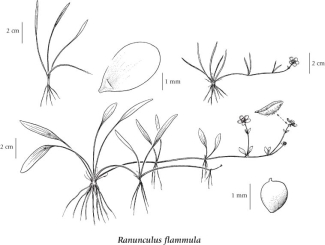Ranunculus flammula L.
lesser spearwort (creeping spearwort; greater creeping spearwort; greater creeping spearwort )
Ranunculaceae (Buttercup family)
Introduction to Vascular Plants
lesser spearwort (creeping spearwort; greater creeping spearwort; greater creeping spearwort )
Ranunculaceae (Buttercup family)
Introduction to Vascular Plants
Species Information click to expand contents
General:
Amphibious perennial herb, usually with stolons and rooting from nodes, roots slender, fibrous; stems decumbent to prostrate, creeping, to 50 cm long, simple to few branched, smooth or sparsely stiff short-hairy, somewhat hollow.
Leaves:
Tufted at nodes, simple, lanceolate or oblanceolate to thread-like, 0.7-6.5 cm long, 0.4-10 mm wide, usually entire, sometimes shallowly-toothed, bases and tips pointed to thread-like; long- to short-stalked.
Flowers:
Inflorescence of solitary, terminal flowers or few-flowered cymes near branch tips, on stalks to 10 cm long; bracts lanceolate or oblanceolate, receptacle smooth; petals 5 or 6, distinct, yellow, 2.5-7 mm long, 1-4 mm wide, egg-shaped, nectary on upper surface, the nectary scale smooth, shallowly cup-shaped, wider than long; sepals 5, spreading or weakly bent back, 1.5-4 mm long, 1-2 mm wide, smooth or appressed stiff-hairy; stamens 10-50; pistils 5-50.
Fruits:
Achenes, several to many in a globe-shaped head 2-4 mm long, 3-4 mm wide, the achenes egg-shaped, 1.2-1.6 mm long, 1-1.4 mm wide, smooth, smooth to net-veined; beaks persistent, lanceolate to linear, straight or curved, 0.1-0.6 mm long.
Notes:
Separation of this species into infraspecific taxa, based mainly on leaf width and flower size, is arbitrary at best. See Calder and Taylor (1968) and Whittemore (1997) for alternative treatments.
Illustration click to expand contents

If more than one illustration is available for a species (e.g., separate illustrations were provided for two subspecies) then links to the separate images will be provided below. Note that individual subspecies or varietal illustrations are not always available.
Illustration Source: The Illustrated Flora of British Columbia
USDA Species Characteristics click to expand contents
Flower Colour:
Yellow
Blooming Period:
Mid Summer
Fruit/Seed characteristics:
Colour: Brown
Present over the Summer
Source: The USDA
Ecology click to expand contents
Ecological Framework for Ranunculus flammula
The table below shows the species-specific information calculated from
original data (BEC database) provided by the BC Ministry of Forests and Range.
(Updated August, 2013)
The table below shows the species-specific information calculated from
original data (BEC database) provided by the BC Ministry of Forests and Range.
(Updated August, 2013)
| Site Information |
Value / Class |
||
|
Avg |
Min |
Max |
|
| Elevation
(metres) |
736 | 150 | 1490 |
| Slope
Gradient (%) |
0 | 0 | 2 |
|
Aspect (degrees) |
0 | ||
| Soil
Moisture Regime (SMR) [0 - very xeric; 4 - mesic; 8 - hydric] |
6 | 5 | 7 |
| Modal
Nutrient Regime
Class |
D | ||
| #
of field plots species was recorded in: |
6 | ||
| Modal
BEC Zone Class |
ICH | ||
|
All BEC Zones (# of stations/zone) species was recorded in |
CWH(1), ICH(3), MS(1), SBPS(1) | ||
|
Source:
Klinkenberg 2013
|
|||
Habitat and Range click to expand contents
Shorelines, wet meadows, marshes and ditches in the lowland, steppe and montane zones; common throughout BC; circumpolar, N to AK, YT and NT, E to NF and S to MN, CO and CA; Greenland, Eurasia.
Status Information click to expand contents
| Scientific Name | Origin Status | Provincial Status | BC List (Red Blue List) | COSEWIC |
|---|---|---|---|---|
| Ranunculus flammula var. flammula | Native | S3 | Unknown | Not Listed |
| Ranunculus flammula var. ovalis | Native | S4S5 | Yellow | Not Listed |
| Ranunculus flammula var. reptans | Native | S5 | Yellow | Not Listed |
BC Ministry of Environment: BC Species and Ecosystems Explorer.
Synonyms click to expand contents
Synonyms and Alternate Names:
Ranunculus flammula var. ovalis (J.M. Bigelow) L.D. Benson
Ranunculus reptans var. reptans